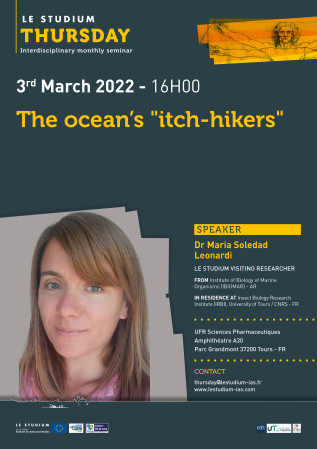Dr Maria Soledad Leonardi

From
Institute of Biology of Marine Organisms (IBIOMAR) - AR
In residence at
Insect Biology Research Institute (IRBI), University of Tours / CNRS - FR
Host scientist
Prof. Claudio Lazzari
BIOGRAPHY
María Soledad Leonardi, born on September 23, 1982, mom of one, graduated from the National University of Mar del Plata, Argentina, majoring in the evolutionary ecology of seal lice. She has over 18 years of experience working with pinnipeds and their long co-evolutionary story with their lice. Soledad Leonardi is an Associated Researcher at the National Scientific and Technical Research Council from Argentina. She has been involved in Antarctic Research since 2014 and is a member of the Working Group Antarctic Wildlife Health Monitoring, Expert Group on Birds and Marine Mammals- SCAR. In 2014, she was awarded the Robert C. Dalgleish Memorial Award to an outstanding young Phthirapterist by the International Society of Phthirapterists.
PROJECT
Adaptations to deep diving in seal lice, the exception to the rule that there are no marine insects
Insects are probably the most successful organisms in the Animal Kingdom, both ecologically and evolutionarily in colonising our planet. However, despite their diversity, very few species have been able to colonize the marine environment. The vast majority of marine insects live associated with the surface of the sea, in marshes, estuaries or shallow waters. In this sense, lice from pinnipeds – sea lions, seals and walruses – are an exception. Seal lice are permanent, obligate, and hematophagous ectoparasites that infest pinnipeds and river otters, that is, hosts with an amphibian way of life. Throughout their evolutionary history, they have adapted to cope with hypoxia, high salinity, low temperature, and, in particular, to tolerate conditions of high hydrostatic pressure. The main goal of this project is unraveling the adaptations allowing seal lice to spend most of their lifetime at depths where no other insect would be able to survive, i.e. the deep sea. This project should provide key information for understanding how seal lice can tolerate the extreme conditions to which they are exposed by the particular biology of their hosts. In a broader sense, it should shed light on the reasons why insects are virtually absent from the ocean realm, which represents 99% of the biosphere of our planet.
Publications
Final reports
Insects are the most evolutionarily and ecologically successful group of living animals, being present in almost all possible mainland habitats; however, they are virtually absent in the ocean, which constitutes more than 99% of the Earth’s biosphere. Only a few insect species can be found in the sea but they remain at the surface, in salt marshes, estuaries, or shallow waters. Remarkably, a group of 13 species manages to endure long immersion periods in the open sea, as well as deep dives, i.e., seal lice. During the evolutionary transition of pinnipeds from land to the ocean, echinophthiriid seal lice had to manage the gradual change to an amphibian lifestyle along with their hosts, some of which may spend more than 80% of the time submerged and performing extreme dives, some beyond 2000 m under the surface. These obligate and permanent ectoparasites have adapted to cope with hypoxia, high salinity, low temperature, and, in particular, conditions of huge hydrostatic pressures. A major remainig question is whether or not seal lice do breath underwater or, on the contrary they dramatically reduce their metabolism to spare oxygen when submerged. During the reported period, we investigated anatomical adaptations to prolongued immersion and also set up a method for measuring oxigen consumption in two media, air and water in small insects, both using state of the art methods.

